Example: How to Consolidate
Last update: 01/2025
The video lecture (the written explanations are below the video)
After summaries of standards related to consolidation and group accounts, I’d like to show you how to prepare consolidated financial statements step by step.
I’ll do it on a case study, with explaining what I do and why. If you don’t like reading, you can skip to the end of this article and watch my video.
If you’d like to revise a theory first, then please read my summary of IFRS 3 Business Combinations and IFRS 10 Consolidated Financial Statements, both of them contain video in the end.
What’s the situation?
Here’s the question:
Mommy Corp purchased 80% shares of Baby Ltd. a few years ago.
Below there are statements of financial positions of both Mommy and Baby at 31 December 20X4.
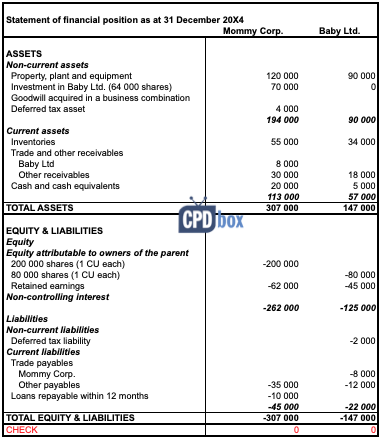
Prepare consolidated statement of financial position of Mommy Group as at 31 December 20X4. Measure NCI at its proportionate share of Baby’s net assets. All retained earnings of Baby are post-acquisition.
Please note here that in the above statements of financial position, all assets are with “+” and all liabilities are with “-“. I use it this way because for me it’s easier to verify and identify mistakes, but it’s up to you.
3 Steps in Consolidation Procedures
I have described the consolidation procedures and their 3-step process in my previous article with the summary of IFRS 10 Consolidated financial statements, but let me repeat it here and follow these steps:
- Combine like items of assets, liabilities, equity, income, expenses and cash flows of the parent with those of its subsidiaries;
- Offset (eliminate):
- the carrying amount of the parent’s investment in each subsidiary; and
- the parent’s portion of equity of each subsidiary;
- Eliminate in full intragroup assets and liabilities, equity, income, expenses and cash flows relating to transactions between entities of the group.
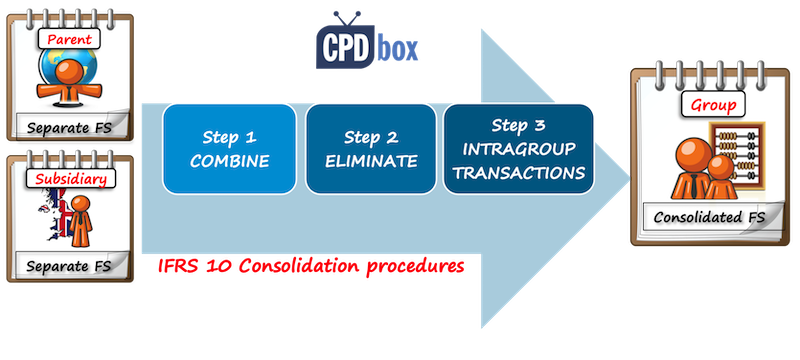
Step 1: Combine
After you make sure that all subsidiary’s assets and liabilities are stated at fair values and all the other conditions are met, you can combine, or add up like items.
It’s very easy when a parent (Mommy) and a subsidiary (Baby) use the same format of the statement of financial position – you just add Mommy’s PPE and Baby’s PPE, Mommy’s cash and Baby’s cash balance, etc.
In reality, companies use their own format for presenting their financial position and therefore it can be difficult to combine. That’s exactly WHY so many groups use their “consolidation packages” and subsidiaries’ accountants must fill them up along with preparing own financial statements.
Therefore, when a group controller calls you every five minutes to remind you the consolidation package, you’ll know why!
In our case study, combined numbers looks as follows:
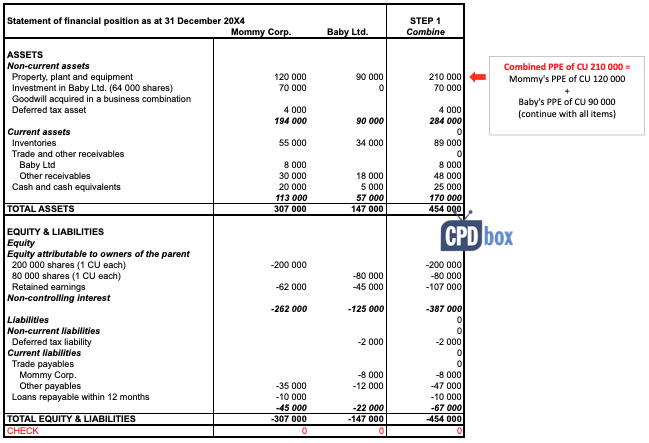
Of course, there are some strange and redundant numbers, for example both Mommy’s and Baby’s share capital, but we haven’t finished yet!
Step 2: Eliminate
After combining like items, we need to offset (eliminate):
- the carrying amount of the parent’s investment in each subsidiary; and
- the parent’s portion of equity of each subsidiary;
and of course, recognize any non-controlling interest and goodwill.
So let’s proceed. The first two items are easy – just remove Mommy’s investment into Baby (CU – 70 000), and remove Baby’s share capital in full (CU + 80 000).
As there is some non-controlling interest of 20% (please see below), you need to remove its share in Baby’s post-acquisition retained earnings of CU 9 000 (20%*CU 45 000).
Wait a second – how do we know that all Baby’s reserves (retained earnings) of CU 45 000 are post-acquisition?
Well, the question says that the full Baby’s retained earnings are post-acquisition, otherwise you need to trace it.
Be careful here, because you absolutely need to differentiate pre-acquisition retained earnings from post-acquisition retained earnings, but here, we’re not going to complicate the things.
Then we need to recognize any non-controlling interest and goodwill.
Non-controlling interest at 31 December 20X4
Mommy has owned 80% of Baby’s share and therefore, non-controlling interest owns remaining 20% of Baby’s net assets.
The question asks to measure non-controlling interest at proportionate share on Baby’s net assets, so here’s how it looks like at the end of the reporting period:
Baby’s net assets are CU 125 000 as at 31 December 20X4, including Baby’s share capital of CU 80 000 and Baby’s post-acquisition reserves of CU 45 000.
Non-controlling interest at 31 December 20X4 is 20% of Baby’s net assets of CU 125 000, which is CU 25 000. Recognize it with minus, as we are crediting equity with non-controlling interest.
Initial recognition of goodwill
There might be some goodwill arisen on initial recognition. If you’d like to learn more about goodwill, please refer to the article about IFRS 3 Business Combinations.
Let’s calculate it. Please don’t forget that we calculate goodwill based on numbers on acquisition, not on 31 December 20X4.
The goodwill is calculated as:
- Fair value of consideration transferred: in this case, we simply take Mommy’s investment in Baby of CU 70 000;
- Add any non-controlling interest at acquisition: here, we’re not adding the non-controlling interest calculated above, as it’s the measurement on 31 December 20X4. At acquisition, the value of non-controlling interest is 20% of Baby’s net assets on its incorporation of CU 80 000 (share capital only). It equals CU 16 000.
- When a business combination was achieved in stages, you would need to add the acquisition-date fair value of the acquirer’s previously-held equity interest in the acquiree, but in this example, it’s not applicable,
- Deduct Baby’s net assets at acquisition: CU – 80 000.
Goodwill acquired in a business combination comes to CU 6 000 (70 000 + 16 000 – 80 000).
The elimination entry looks as follows (sign “+” indicates a debit entry; sign “-“ indicates a credit entry):
| Description | Amount | Debit | Credit |
| Remove Mommy’s investment in Baby | -70 000 | FP – Investment in Baby | |
| Remove Baby’s share capital in full | +80 000 | FP – Baby’s share capital | |
| Remove 20% (NCI) of Baby’s post-acquisition retained earnings | +9 000 | FP – Retained earnings | |
| Recognize non-controlling interest on 31 December 20X4 | -25 000 | FP – Non-controlling interest | |
| Recognize goodwill acquired in a business combination | +6 000 | FP – Intangible assets (goodwill) | |
| Check | 0 |
I have transferred this journal entry into our consolidation worksheet and it looks as follows:
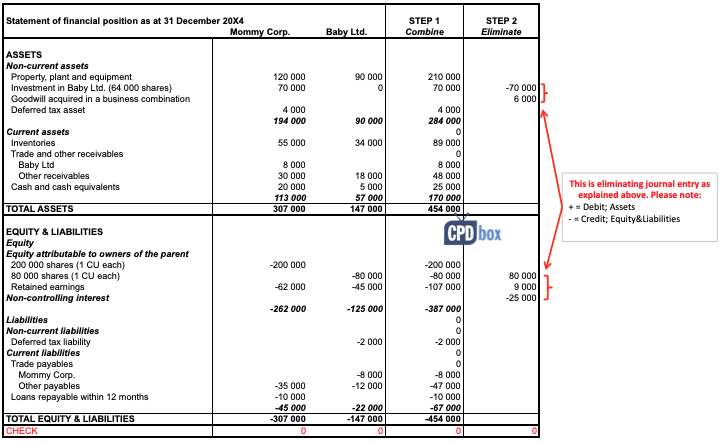
Eliminate Intragroup Transactions
Parents and subsidiaries trade with each other very often.
However, when you look at both parent and subsidiary as at 1 company, which is the purpose of consolidation, then you find out that there’s no transaction at all.
In other words, group has not performed any transaction from the view of some external user.
Therefore you need to eliminate all transactions happening within the group, between a parent and its subsidiaries.
Looking to above individual statements of financial position of Mommy and Baby you see that Mommy has a receivable to Baby of CU 8 000 and Baby has a payable to Mommy of CU 8 000. Perhaps these 2 items relate to the same transaction between them and we need to eliminate them, by debiting payables and crediting receivables:
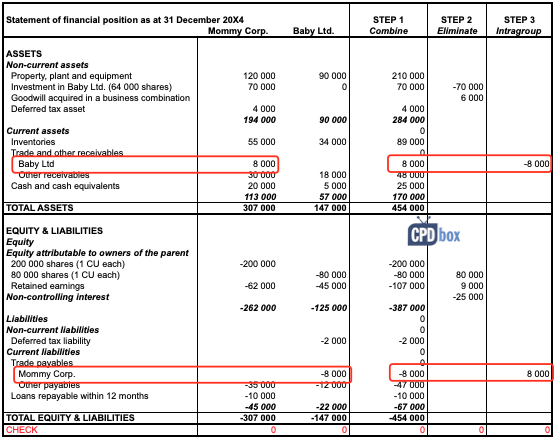
Final steps
After we have completed all steps or consolidation procedures, we can add up all the combined numbers with our adjustments and thus we arrive at consolidated statement of financial position.
You can revise all the steps and formulas in Excel file that you can download at the end of this article.
Here’s how it looks like:
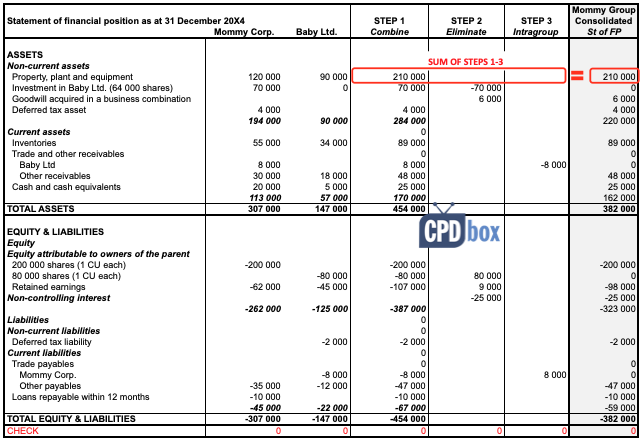
Please note the following facts:
- Consolidated numbers are simply sum of Mommy’s balance, Baby’s balance and all adjustments or entries (Steps 1-3).
- Mommy’s investment in Baby’s shares is 0 as we eliminated it in the step 2. The same applies for Baby’s share capital and consolidated statement of financial position shows only a share capital of Mommy (parent).
- There’s a goodwill of CU 6 000 and non-controlling interest of CU 25 000, as we have calculated above.
- Consolidated retained earnings are CU 98 000 and they consist of:
- Mommy’s retained earnings of CU 62 000 in full, and
- Mommy’s share (80%) on Baby’s post-acquisition retained earnings of CU 45 000, that is CU 36 000
Exam-style consolidation
I know that many of you prepare for your exams and this is NOT the way how you learned consolidation during exam preparation courses.
OK, I understand.
I prefer this way of making consolidation by far, because here, you go systematically, step by step. You can deal with each adjustment in a separate column and as a result, your numbers will always balance. You will never forget anything.
The “exam-style” of making consolidated financial statements is good and easy when there are just a few issues or complications.
But when you need to deal with more complex situations, then you can forget or omit the things very easily. Trust me, I did it too.
However, to make you happy, you can find the same case study solved “by the exam-style” in the attached excel file that you can download in the end of this article.
Is consolidation really easy?
Sometimes.
But in most cases, there is lots of issues or circumstances that you need to take into account and exactly their significance and amount makes it all difficult.
What issues? For example:
- Consideration transferred for acquiring the shares may involve not only cash, but also some other forms, such as share issue, contingent consideration, transfers of assets, etc.
- Non-controlling interest can be measured at fair value instead of at proportionate share.
- There might be some unrealized profit on transactions within the group and it needs to be eliminated.
- There might be some transfer of property, plant and equipment at profit within the group and as a result, you need to adjust both unrealized profit and depreciation charge, too.
- Goodwill might be either positive or negative (=gain on a bargain purchase). Moreover, it can be impaired.
- Subsidiary’s net assets might be stated in the amounts different from their fair value, or even not recognized at all.
- Subsidiary may show both pre-acquisition retained earnings and post-acquisition retained earnings. You need to be extremely careful in differentiating them and dealing with them separately.
I can go on and on, but I don’t want to discourage you. However, if you need to know more about all these issues, I have covered them fully in my premium learning package the IFRS Kit, so please check out if interested.
Further reading: Here’s the list of all articles and videos published on CPDbox on consolidation – totally free.
If you like this example and explanations, please help me spread a word about it and share it with your friends. Thank you!
Tags In
JOIN OUR FREE NEWSLETTER AND GET
report "Top 7 IFRS Mistakes" + free IFRS mini-course
Please check your inbox to confirm your subscription.
Recent Comments
- Albert on Accounting for gain or loss on sale of shares classified at FVOCI
- Chris Kechagias on IFRS S1: What, How, Where, How much it costs
- atik on How to calculate deferred tax with step-by-step example (IAS 12)
- Stan on IFRS 9 Hedge accounting example: why and how to do it
- BSA on Change in the reporting period and comparatives
Categories
- Accounting Policies and Estimates (14)
- Consolidation and Groups (25)
- Current Assets (21)
- Financial Instruments (56)
- Financial Statements (54)
- Foreign Currency (9)
- IFRS Videos (74)
- Insurance (3)
- Most popular (7)
- Non-current Assets (56)
- Other Topics (15)
- Provisions and Other Liabilities (46)
- Revenue Recognition (27)
- Uncategorized (1)

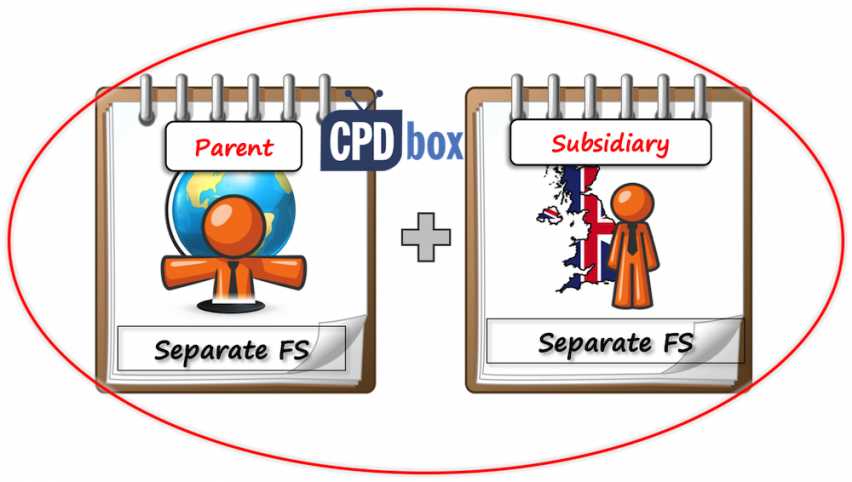



Thanks for this articles. Your work has been of great help to me.
Hi Silvia
I have a question regarding the impact of IFRS 15 on group consolidation. Consider two companies A and B who each have their own contract under IFRS 15 with the same customer. At consolidated level, though, the two contracts have the same commercial purpose ( example an IT project that is partly delivered by the US subsidiary and partly delivered by India) so based on IFRS 15, they should be combined.
Is it ok to combine these contracts into one single contract and redo the allocation at the consolidation level? As a result, the consolidated retained earnings account might not be equal to the sum of retained earnings accounts of the two companies.
Is this allowed?
Thank you very much in advance
Thank you so much!
Hi Silvia,
please provide me your email.
you can send an email through mine:lneah16@gmail.com
Hi Luke, there is a contact form to write me an e-mail. S.
Hello Silvia,
I have a the following dilema. I work in company A (Romania) that has as an investor an investment entity ( H(olding) – from Austria.
A company has 2 subsidiaries ( 100% in both) B ( Czech) and C (Germany). Until now we consolidated in company A (Romania). At the end of 2018 the board intends to bring companies B and C under direct control of H, meaning that A will sell to Holding the 2 subsidiaries.
From 2019 who and what will consolidate? As far as i undestood from IFRS 10 Exceptions, the investment entity does not need to prepare consolidated FS. But who will present the activity of the grup?Will the consolidated FS be done only with companies A, B and C, or also with H?
Thanks in advance,
Alina
Hi Alina,
it depends who exercises control of B and C after 2018. If it is investment entity and A loses control of B and C, then yes, investment entity H must assess whether to consolidate or not. There are some conditions when investment entity is prohibited from consolidating subsidiaries and when it must consolidate (it is not automatic). If H is prohibited from consolidation and gains control of B and C, then H shows B and C under IFRS 9, not under IFRS 10 (investments at fair value, not consolidation).
It can happen that only ownership share is transferred to H, but control stays in A – in this case, A consolidates (similarly as consolidating special purpose entity).
So first, you need to perform some assessment of the situation and control, then analyze the exception of investment entity (whether applies or not) and then decide. S.
Thank you for these. I work for a big 4 accounting firm and consolidation is always a challenge.
Hi Silvia,
I have given an assignment to do a business evaluation report and I am confused on the structure or the content of the business valuation report.
Thank you!
I cannot thank you enough, Silvia. Good job on Group Accounts.
If parent company is formed during the year and acquired a subsidiary during same year.
When consolidating is there any special things to take care ?
and when disclosure all the balance of subsidiary should be shown under additions or opening balance?
Excellent work Silvia! I absolutely loved it, thank you very much for your help. Keep up the good work! 🙂
If Parent acquires 100 % of Subsidiary’s share,does parent require to consolidate parent’s FS.
Yes 🙂
how am i calculate the nci of any group.
Dear Silvia,
I have a question regarding the unrealized profit I would be grateful if you could help.
What happens, when one subsidiary A (producer) sells inventory to another subsidiary B for whom the inventory is PPE.
I understand that the profit will be eliminated the first year when consolidating the statements by the Parent company, but what happens afterwords?? Should the Parent still continue ignoring the depreciation charge of the PPE in the amount of the unrealized profit? Could you please explain.
Thanks in advance.
Hi Silvia,
How can I purchase the IFRS Kit?
Hi Rochell, you can do so here: https://www.cpdbox.com/ifrs-kit – simply click “Get Instant Access” on this site. S.
Hi Silvia,
Thanks a lot for your so simple and well explained Summaries.
Highly appreciated !!
Hi Silvia,
What if the subsidiary makes a redemption of its own shares and let’s say that 5% of the shares of the NCI are redeemed, how will this be shown in the consolidation of the parent?
Thank you!
Hi,
Very good explanation. Thanks! I wonder how you arrived at non-controlling interest of 20% ? Shouldn’t this be 12.5% ((80000-70000)/80000) ?
NCI = 20% – it’s what the parent does not own, i.e. 100%-80%.
Hi Silvia,
I liked your simple and effective way for presenting this complex subject. I rate this as one of the best I have come across. Thank you.
Best,
Sivaraman
Hi silvia, can i ask u question about consolidated statement?
Hi silvia,
Thank you for the post. Can i ask about consolidating other financial statements apart from statement of financial position. is it just simply adding revenue and cost or is it required any adjustment like this?
Hi Amy, great question. I’ve just realized that maybe I did not cover it up here, so I’ll do it in the future. Yes, you do need to adjust, too – but not that many adjustments. You still remove intragroup sales/cost of sales. I have published one example on consolidated cash flows – maybe this helps. S.
Hello, thanks madam Sylvia for the wonderful articles about IFRS.
How can I compute the percentage of parent’s control and NCI minus considering the shares acquired? Is there any other way? Thanks
Hi Kapala,
hmmm, I don’t think I understand your question fully. The example assumes that you know how many percent you acquired…S.
Hi Silvia,
Thanks for your amazing explanation.
Can I ask something, please?
May it’s a stupid question, but just for clarify my doubts…
Why does Baby’s share capital need to be cancelled/eliminated ?
Thanks
Hi Helen, because from the external point of view, there is just one share capital of the group – the share capital of the owners of the group. S.
Hi,
Just want to know, what steps are taken to consolidate the balance sheet of 100% (wholly owned) subsidiary. Are we need to eliminate equity and transactions only? Please help.
Should the Parent company purchase the final say 20% of a sub what happens to the accummalated MI reserve to date?
Good day, hope you can help me,
I would like to know, if Company A holds 60% interest in Company B Company B had non distributable reserves which was consolidated as 60% inclusion and 40% as NCI in 2016, in 2017 the NDR converted to share capital. How will this effect the consolidated AFS in 2017?
Hi,
Thank you for making it easy to follow. Now I can get that consolidated statement of financial position balanced every time.
Hi
If subsidiary’s financial date is different with mother company how to do the consolation also different currency.please explan
Hi,
I’m a Software Programmer working for an accounting firm. This article has answered so many questions that I couldn’t figure out even after hours of google search and book reading.
Thanks for the simplifying the concept.
Regards,
Pradeep Naik
Great, I’m glad to help 🙂 S.
Hello Silvia, kindly advice how to show dividends paid from pre-acquisition profit. For example, mother paid 100 for 80 net-assets of baby (100%) and later collect 60 dividend from preacquisition earnings. Thank you in advance
Hi Violeta, it reduces the cost of investment.
Thanks
It is simple and clear for apply.
Thank you so much.
Dear Silvia,
Thank you for this very informative example. But I do have one question concerning consolidation. IFRS 24 requires entities to consolidate their statements regardless business activities are same or not. So can you please tell how can a production company’s financial statements be consolidated with its subsidiary’s fin. statements, when the subsidiary is a bank, insurance company and etc.
I’m sorry i meant IAS 27 and IFRS 10
Hi Silvia
I just wanted to say THANK YOU for your amazing resources on this website. I used them to revise at the last minute for a job interview at a huge company with many complex consolidations and they offered me the position even though my actual experience in acquisition accounting was limited.
Very grateful!!
K
Hi Kit,
amazing, congratulations!!! 🙂 I’m happy to be a part of your success 🙂 I hope my web will help you in your new position, too! S.
Hi, what happens if the subsidiary being consolidated also has goodwill in their FS from a previous acquisition. What happens to this goodwill on consolidation by the end parent? Thank you
Hi Silvia,
This is a great article. Thank you for putting it together.
What would be the journal entries in the books of Mommy Corp. and Baby Ltd. if Mommy Corp. were to acquire a 100% of NCI?
Thanks!
Hi Omar,
I don’t understand fully. Are you asking about the situation when non-controlling interest is 100%? So in this case, Mommy owns zero, but it can still be necessary to consolidate, because Mommy could still exercise control over Baby (not based on ownership, but based on something else).
Also, as Mommy acquires 0 in Baby, then the goodwill is equal to the investment of CU 70 000. The journal entry would be therefore Debit Goodwill 70 000, Credit Investment 70 000, Debit Share capital of Baby 80 000, Debit Retained earnings of Baby 45 000, Credit NCI 125 000.
It may seem strange, but similar situations happen a lot with special purpose entities. S.
Hi Silvia,
Thank you for the great article.
May I ask a question on PPE please. If subsidiary has different policy from parent – subsidairy values PPE at cost , but parent revalue PPE subsequently. How do we consolidate the PPE line please?
Thank you.
Hi Kim,
a parent and a subsidiary must apply the same accounting policy. Therefore, before consolidating, a subsidiary should adjust its accounts so that PPE is valued using cost model as its parent. S.
Dear Silvia, thank you so much & i have taken ur advise seriously
3.the question is why we aren’t calling it as equity instead of net assets since it covers the elements of equity only.
Thank you so much for ur response. I do Appreciate ur effort.
Could you please get me clarifications on the below points.
1. What would be the reason behind recording Parent’s share plus Subsidiary’s share(for instance 80%+20%) in the CSOFP instead of 80% Parent’s alone!
2. Unrealized Profit – could you please explain how & under what all circumstances does it generates !
3. Good will computation –
Consideration paid xxx
add. FV of NCI @ acquisition date xxx
Less: FV of Net assets of subsidiary
@ acquisition date
a. Share capital
b. Share premium
c. R/E
d. R/S
e. FV adjustments (if any) (xxx)
Good will xxx
Why are we using the word “net assets” to the above figures corresponding to (a,b,c,d & e) ?
Dear Rejeesh,
I would strongly recommend you reading a good book or taking some good courses on consolidation, because your questions go beyond what I can respond in the comments. But I’ll try shortly:
1. Because a parent controls the whole subsidiary, not just 80% of it. That’s why you show non-controlling interest – to report that although the parent controls 100%, 20% is owned by someone else.
2. E.g. when parent sells goods to a subsidiary at profit and they remain unsold at the end of the reporting period – from the group’s point of view, there is no profit because there was no sale. Please consider reading the book 🙂 or my IFRS Kit 🙂
3. Because the sum of these numbers EQUALS the net assets. The basic accounting equation is that Assets = Equity + Liabilities; hence equity = assets – liabilities = net assets. S.
Dear Ms.Silvia
In group consolidation, how we may compute the value of goodwill if the consideration paid are in shares or any other assets rather in terms of liquid cash.
Dear Rejeesh,
in this case, you need to determine the fair value of consideration transferred – i.e. the fair value of the shares or any other assets given up in return for the investment. S.
Silvia
I can’t thank you enough for your articles and for the IFRS kit! It’s the first time someone teaches me IFRS the way it is actually done in practice! The case studies in excel are just great. I initially needed only a consolidation refresher but I got so excited that I will follow the entire course and I will aim to pass dipIFR sometime in the near future.
Keep up the good work!
Cheers
Kostis
Completamente de acuerdo, yo diría que es impúdica. Raya lo ofensivo, la verdad.
bague b zero1 http://www.bzero.cn/fr/bvlgari-bzero1-1-bande-bague-en-or-rose-18-carats-p-215.html
I would like to know, if the parent company acquires 100% shares by way of making payment to the shareholders, initially what would be the entry in subsidiary books and then at the time of consolidation, at what value would the investment in parent company and share capital in subsidiary be shown.
If for eg, Parent company acquired 100% shares at price of .50 paise where the share price of subsidiary is rs. 10 each for 1000 shares.
First how would be the share capital shown in subsidiary balance sheet. Will it be shown as 10000 Rs. or Rs.500 in share capital account.
Second, Investment in Parent company would be shown as Rs. 500 for 1000 shares. So at the time of consolidation, how would the books and balance sheet be shown.
Dear R bhatia,
when parent acquires the shares in subsidiary for cash, it does NOT affect subsidiary’s accounts. It still remains the same.
The parent’s investment will be shown at Rs. 500 for 1 000 shares. Then at consolidation, the investment of Rs 500 cancels out agains subsidiary’s net assets and if there’s something left, it’s goodwill. S.
Thank you very much!
Good presentation. Kindly do the same for statement of financial performance, especially first year consolidation.
Hi Silvia, first of, would like to commend you for such an excellent website you have. I’ve found it extremely resourcesful and your explanations are enjoyable!
I have a question regarding consolidation of group accounts as an on-going month-end preparation.
After the consolidation above, what would be the practice in a real-life situation during every month-end? Will these steps be redone every month?
Thanks so much in advance, you are a superstar!
Hi Silvia,
My case is 100% invest and control of the subsidiary. Do i still need to calculate NCI? My investment in Mommy’s company is 10K, Share capital in subsidiary is 100K. My transaction to net off the investment are as follows :-
Dr. Share capital (in subsidiary) – 100,000
Cr. Investment (in mommy’s company) – 10,000
Cr. Goodwill acquired in a business combination – 90,000
Is that correct? Please advise
Thanks
Hello Silvia,
My question about calculating the consolidated cost of sales, where there is an intra group transaction (downstream),and time apportionment.
the formula is:
parent cost of sales + subsidiary cost of sales apportioned by time – intra group
the question is :why the intra group amount of subsidiary purchases is not eliminated first before time apportionment, and then only the remaining will be time apportioned?
That because, if we did the time apportionment for the all cost of sales amount,that we means that we apportioned the intra group, which should have been entirely eliminated before the apportionment?
Right?
Dear Younes,
as you know, you eliminate intragroup profit only on those purchases (intra-group sales) that relate to inventories still in the warehouse (unsold by the group to third parties). You may reasonably assume that this relates to the latest purchases/sales in the reporting period. That’s why you first time-apportion and only then remove intragroup profit.
However, let’s say that P acquired S in June and the last intragroup purchase happened in May. At the year-end, inventories are still unsold. In this case, you do NOT eliminate any intragroup profit, because this intragroup purchase is NOT intragroup – it happened prior acquisition. I hope it’s clearer now. S.
Hello Silvia
In accordance with IAS is the goodwill arising on acquisition appears at the individual S.F.P, or it is already included at the investment account ?
Hi Coop, goodwill is not recognized as an asset in the individual statement of FP. Instead, you keep investment either at cost, using the equity method or as a financial investment under IFRS 9. S.
Hello Silvia, I need to find answer about 3 cases I’ve met, 1) How to measure unrealized profit for services provided to subsidiary,
2) when Parent company invest in subsidiary with only assets as consideration transferred at acquisition, so when we prepare the later consolidated financial position shall we eliminate the capital gain in parent accounts?
3) how we record the broker fees when parent acquired subsidiary stocks from deal in market.
Thanks
Dear Haytham,
1) Is this necessary? When a parent provides the services, P shows the revenues and S shows expenses – these are both eliminated at consolidation, so there is no unrealized profit to eliminate.
2) I assume you mean the difference between the fair value of assets given up and their carrying amount. No, you should not eliminate it, because this is not the transaction with a subsidiary – it’s a transaction between the parent and the previous owners of that subsidiary.
3) In the consolidated financial statements, these are expensed. In the separate financial statements, the transaction costs are a part of the cost of investment.
Many thanks Silvia, I understanding from you there isn’t unrealized profit for services (just for stocks), is that right?!
Yes, Haytham, because you don’t have anything left in your balance sheet when you buy/sell a service (however, inventories can remain unsold). S.
But, please it that capital gain on fixed assets shown in financial statement even the Parent ESTABLISHED the subsidiary with other investors.
Have a Consolidation sample for Holding company with foreign subsidiaries? I want to know exchange difference on inter-co transactions (e.g loan bwetween holding & subsidiary company, sales & purchase, how to make elimination in Consolidation?
Hi
A very lucid and handy explanation of the hard-to-understand concepts. Thank you very much.
Regards
KSolaiappan
Hi Silvia,
A company “A” has booked purchase from another company “B” in the year 2014 when they are unrelated, but no sales was booked by company “B”. In the year 2015 both companies A and B were acquired by another company “C”.The individual balance sheets and both companies are already audited and auditor skipped to rectify the un- reconciled sales and purchase between “A” and “B”. Now while consolidating the balance sheet of “A” “B” and “C” in the year 2015, what effect shall I give to rectify the receivable and payable difference? Can I adjust it with the retained earnings in the consolidated balance sheet?